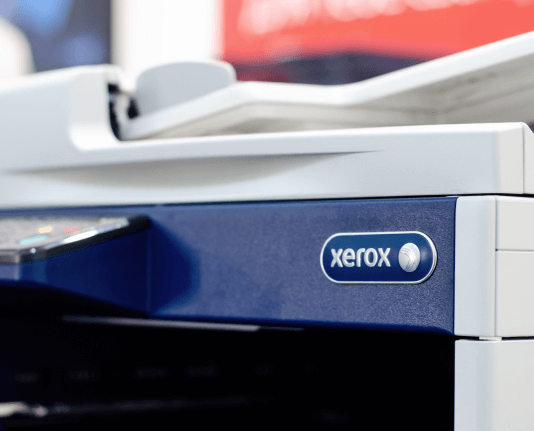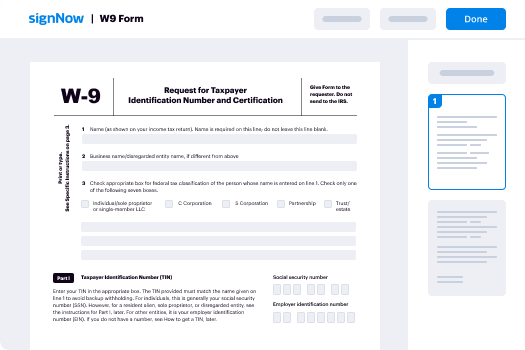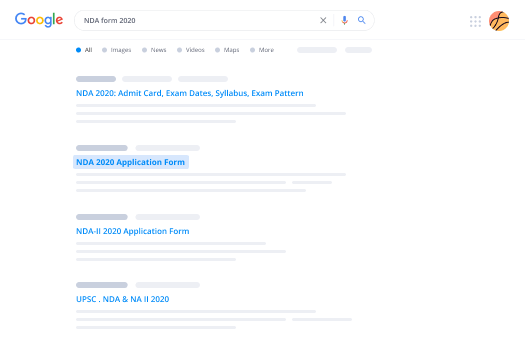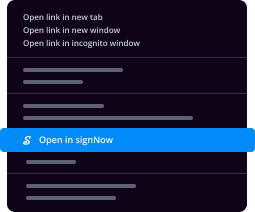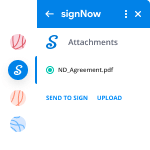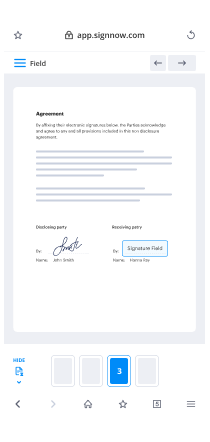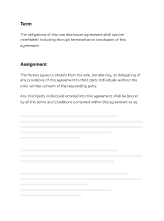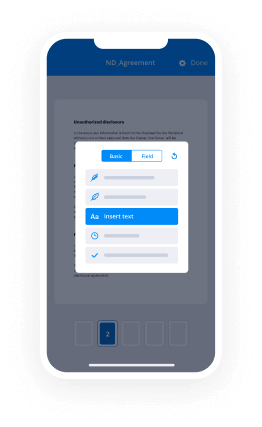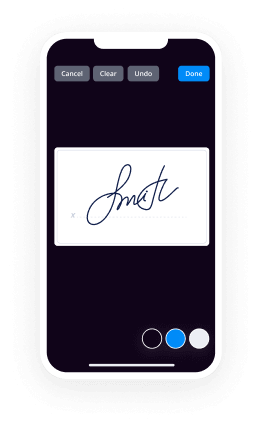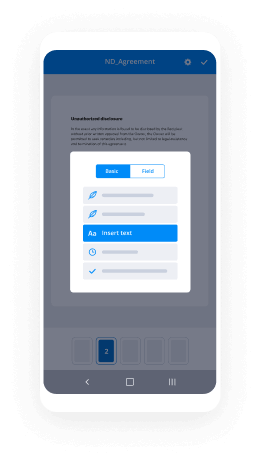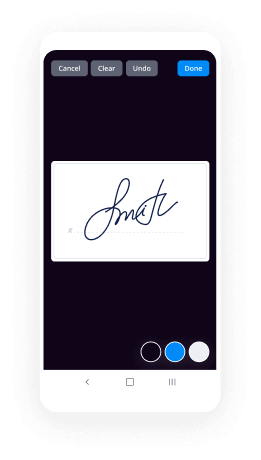Help Me With Integrate Sign in Box
Contact Sales
Make the most out of your eSignature workflows with airSlate SignNow
Extensive suite of eSignature tools
Robust integration and API capabilities
Advanced security and compliance
Various collaboration tools
Enjoyable and stress-free signing experience
Extensive support
Keep your eSignature workflows on track
Our user reviews speak for themselves






Assist me with this: advantages of airSlate SignNow
If you're in search of a dependable option to optimize your document signing procedure, you might be thinking, "Assist me with this!" airSlate SignNow provides a range of advantages that facilitate eSigning and boost productivity for enterprises of all scales. By utilizing this platform, you can enhance efficiency and minimize paperwork inconvenience.
Assist me with this: how to utilize airSlate SignNow
- Launch your web browser and head to the airSlate SignNow website.
- Opt to either register for a free trial or log into your current account.
- Upload the document you intend to sign or request signatures for.
- If you plan to use this document repeatedly, create a template for future utilization.
- Access your document to make essential modifications, such as incorporating fillable fields.
- Sign your document and add signature fields for other parties.
- Click 'Continue' to set up and distribute the eSignature invitation.
In conclusion, airSlate SignNow not only streamlines the signing procedure but also provides businesses with a comprehensive feature set that maximizes return on investment. Its user-friendly interface and transparent pricing model make it especially attractive for small to medium-sized enterprises.
Ready to improve your document workflow? Start your free trial with airSlate SignNow today and witness the benefits firsthand!
How it works
Rate your experience
-
Best ROI. Our customers achieve an average 7x ROI within the first six months.
-
Scales with your use cases. From SMBs to mid-market, airSlate SignNow delivers results for businesses of all sizes.
-
Intuitive UI and API. Sign and send documents from your apps in minutes.
A smarter way to work: —how to industry sign banking integrate
FAQs
-
What features does airSlate SignNow offer for document signing?
If you're looking for an efficient way to manage your documents, airSlate SignNow can help me with that. It offers features like customizable templates, in-person signing, and advanced security options to ensure your documents are signed quickly and safely.
-
How does airSlate SignNow pricing work?
Many potential users ask about pricing, and airSlate SignNow has flexible plans to help me with that. Whether you need a basic solution for a small team or a comprehensive package for a larger organization, our pricing is designed to fit various budgets and needs.
-
Is it easy to integrate airSlate SignNow with other software?
Absolutely! If you're wondering how to streamline your workflow, airSlate SignNow can help me with that by integrating seamlessly with popular applications like Salesforce, Google Drive, and more. This allows you to enhance productivity without disrupting your existing processes.
-
What are the benefits of using airSlate SignNow for my business?
Using airSlate SignNow can signNowly improve your document management processes, and if you're curious about the benefits, it can help me with that. From reducing turnaround times to enhancing security and compliance, our solution is designed to optimize your workflow and save costs.
-
Can I use airSlate SignNow on mobile devices?
Yes, you can! If you're often on the go and need a reliable signing solution, airSlate SignNow can help me with that. Our mobile app allows you to send, sign, and manage documents directly from your smartphone or tablet, making it easy to stay productive anywhere.
-
What security measures are in place with airSlate SignNow?
Security is a top priority for us, and if you have concerns, airSlate SignNow can help me with that. We implement robust encryption protocols, multi-factor authentication, and regular security audits to ensure your documents are protected throughout the signing process.
-
How can I get started with airSlate SignNow?
Getting started is simple! If you’re wondering how to begin, airSlate SignNow can help me with that by providing a user-friendly sign-up process. You can choose a plan that fits your needs, and our setup wizard will guide you through creating your first document.
-
What is Feynman's trick?
Here is something I found on the internet on Feynman’s trick.http://fy.chalmers.se/~tfkhj/Fey...It has theorems and some examples that explain the concept beautifully.It’s better if you understand it through the link I am providing instead of me explaining it here.A note: Feynman talked about this in his autobiography, “Surely your joking, Mr. Feynman.” He mentioned this as one of different tools in mathematics he used to solve problems. This trick is actually mentioned in the text by Frederick S. Woods called “Advanced Calculus.”Apparently this trick isn't taught much in Universities around the world, so, I guess it would be a good opportunity to learn something different and interesting!Thanks for asking the question, I learned something new as well!
-
If a person wanted to radically change his/her life, what would be the first step to take?
Simple, by leveraging a radical change to your normal environment.This is one of the most powerful concept which I came to know about recently, while reading the book “Deep work” - by Cal Newport.Well, the concept which I am talking about is quite dangerous to look at, but it is perhaps what most of the huge success people did, in order to stay to their path.Whenever I look at the best way to earn, or live life; I have always thought that the best return of investment is I should invest least time and money, just what is required, and gain maximum profit out of it. I always had a fantasy while thinking about those kinds of works, which either need initial hard-work, one time work, or less work and more return. And if we look at enormously successful people, all of their jobs are like that. There are a lot of stats of how much a billionaire earn in a minute.There was a saying in my college days, if Bill-Gates drop a dollar, he will waste more money while picking-up that dollar from the floor. Because he earns more in few seconds than that.But then I read about this phenomenon, which very few people are aware of….what these hugely successful people do.Let me tell you a few examples, which the book quoted:J.K. Rolling was not able to write the seventh edition of Harry Potter “The Deathly Hallows”. She was nervous and afraid to bind all the characters together and give a nice ending to the story to satisfy millions of its fans. To overcome this, she shifted from her home to a luxury hotel suit just to write the book. The hotel was very expensive, but it was all worth it.Bill-Gates was regularly taking “Think Week” breaks during which he would leave behind his normal work and family obligations to retreat to a cabin with a stack of papers and books. His goal was to think deeply without distractions, about the big issues relevant to his company.William Shockley locked himself into a hotel room in Chicago, to iron out the details for a better design of “transistor”. He later ended up getting Nobel prize.Peter Shankmann, an entrepreneur and social media pioneer found out he was more productive during flights as there was no distractions and he was tied to the chair having no choice but to work. So he took a project with very short deadline, for that he booked a round flight to Tokyo to write manuscript in air. He wrote during the whole journey and came back in same flight. He completed the manuscript which had 2 weeks of deadline in just 30 hours. He spent 4000$ on flight ticket and earned way more.This technique is called Grand Gesture, not every grand-gesture needs to be so permanent.But if we see at the above examples, we can see what is common here. By leveraging a radical change to your normal environment, coupled perhaps with signNow investment of effort or money, all dedicated towards supporting a task, you increase the importance of that task.It is quite simple to look, that by investing so much we can make our work a Priority. Thus, you will be bound to give all your effort in your work. This boost in importance reduce your mind’s instinct to procrastinate and delivers an injection of motivation and energy.I suggest to read the book. It is a way to enable deep work into your life style.Cheers!
-
Why are so many games becoming Epic Games exclusives?
Because for a title to become an exclusive, an agreement of exclusiveness has to be made, so as to compensate for being unavailable to other platforms.And Epic, having a massive user base (mainly due to Fortnite), a far larger capital than Valve, and yet a tiny game collection, is far more keen to make such agreements and offer much better deals to game developers.From the aspect of a game developer, even in the improbable case that the offered deal was the same, I’d rather have my game be one amongst a collection of about 50 games, rather than be lost in vast collection of Steam’s games.Being in Epic’s collection is an advertisement by itself, and Epic is no underdog, has signNowed its critical mass, so I see no disadvantages of being there instead of Steam.From gamer’s aspect, Epic made a very good marketing move, offering free games to get us accustomed to its platform, which was highly appreciated, and makes you feel you owe something back to them. That’s something that I have never seen Steam doing.Many of its offers are also very good, so why not buy from them, even at the expense of having several game-platform clients running on my PC at the same time :-)As for the client applications, I don’t think that they play any signNow role in favor of Epic. Quite the contrary, Steam Client may have very serious problems, performance and otherwise, but is still by far superior to any other platform’s. They have Linux and Mac clients, they have implemented operations like moving/backing up installations, and they have a decent search. It’s also stand-alone, meaning that it doesn’t transfer you to the browser to finish unimplemented operations. It also shows you which games in the store you already own, something which Epic seems not to have yet implemented. (no problem for now, of course, as long as they are so few that they can be easily remembered). Another thing that turned me off in Epic store was that, when buying multiple games, I had to make a separate purchase for each one, an inconvenience that I hadn’t experienced in the other platforms. Not that it prevented me from buying, but it contributed to that sense of “still-a-beta”.Steam review system may also have its problems, but, it still is where I resort reading when I want to buy a game, even from another platform. Not only to see the total verdict, but to read some of the common problems of those with negative reviews. On the other side, reviews in other platforms seem far more subjective or even biased (i.e. many GOG’s reviews seem too nostalgic), while I can’t even find where the reviews on Epic store’s games are.If I have a complaint about Steam’s review system, it would be that small, retro games sometimes get overrated, and not the other way around. I mean, c’mon, overwhelmingly positive, with pixel graphics?So, I don’t know about Steam’s policies against indie developers (and they may be bad, indeed), but its review system seems to be in favor of them, while giant companies, like EA, sometimes get the flame. (and sometimes they deserve it).
-
Why do some programmers prefer Windows over Linux?
Edit: Based on Hamed Zitoun’s comment. They prefer it because they have the luxury of using .Net.I’ve worked for years on Linux systems, but after 3 years on the Microsoft stack I’m firmly convinced that Windows offers us the single most advanced development ecosystem in the world.I can’t cover every benefit that you get from Data Analysis, modeling, R integration, C#, SQL, Development environment etc. But I’m going to try and give you a taste of the workflow that Microsoft gives you.Sprint Planning on TFSLet’s look at our workflow, we start by planning our Agile sprints on TFS. Our projects managers assign stories, track burn downs, generate reports and we go back to our desks with a set of tasks.Starting DevWhen we open Visual Studio all of our work items (tasks) are there waiting for us.Intelli Sense and Code qualityBefore I even begin to change any code Visual Studio is telling me what I’m dealing with. I can see how many references there are to each function, the number of unit tests, code reviews, authors and even the number of times this function has triggered errors in production.Daniel Turan’s image:I can also rely on generated code maps and analysis tools to help me discover the logic flow of the feature I’m working on.When I begin to write code I have the full support of the C# language and tooling which was designed from the ground up to give you the best possible intelli sense and real time code quality information and templating.See Daniel Turan’s answer for more on this.The ReSharper tooling takes this to the next level, check out there showcase for more:ReSharper :: Features - The Most Intelligent Add-in to Microsoft Visual Studio .NET for professional software developers offers support for C#, Visual Basic .NET, ASP.NET, XML, and XAML, and provides refactorings, unit testing, and many more featuresConverting a loop to a single line Linq query:Debugging and Performance profilingI won’t go into this too much as there is far too much to cover, but Visual Studio offers some of the best performance profiling and multi threaded debugging tools available.Database IntegrationVisual Studio is completely aware of SQL Server and bridges the gap between your code and your DB seamlessly. Through Entity Framework my models are kept constantly in sync with my DB which I design and update without even leaving Visual Studio.This allows for some fantastic benefits like receiving JSON data from a HTTP push, mapping that down to a fixed datatype and inserting a row in your DB all in a single line of code.Web Server IntegrationVisual Stuido, C# and IIS work together like old friends. My web server settings for both production and dev are driven and configured entirely from a single code base.Code ReviewOnce my code has been completed and I’m ready for code review I don’t even leave my IDE.Ready to close a TaskCode reviews are done, unit tests are passing the testers have signed off and I’m ready to close my task. I push my code commit up, linking it to my tasks with comments. This puts a smile on my project managers face as another notch immediately comes off her down down chart and the task is marked as closed on TFS.Deployments and AzureI’m not even going to go into this, the benefits are obvious and deep. Having a development environment that is deeply integrated and backed by one of the worlds largest cloud environments takes things to a level that no one can compete with.When you set out to start a new C# project this check box speaks volumes about how much Azure gives you.TLDRMicrosoft is a company that charges a small fortune for its software environment and that fortune is what allows it to out perform and out compete any other open source product, not only in functionality but also in sheer scope and scale of their thinking.It is an environment that’s completely aware of itself. Right down to the machine you’re working on and the user you have logged in as. You have access to all of it, and all of it is integrated seamlessly into some of the most advanced tooling in the development community.Don’t get me wrong, I still love Linux and I always will. As a compute user you lose a lot when you buy into this Microsoft world (customization and control) but I know this much. As a developer, I’ve never been more productive.
-
What is the most clever life hack you've learned?
When shopping online, always read the 1-star reviews first.If you see a car accident call the police. It may seem obvious but many believe that someone else will do it.Don't right-click-correct incorrectly spelled words. Delete the entire word then re-type it correctly. Do this to train yourself to spell words right the first time instead of relying on spell-check.While having dinner at someone’s house, intentionally take smaller portions than you normally would. If you don’t like the meal you’ll be glad you don’t have too much, and if you do like it you can flatter the host by asking for more.Before/While watching a TV show or movie try not to look at reviews.Before booking a vacation online, call the booking agency directly and ask any question. They will likely give you a discount for calling.Apply for a loan a day or two after your normal pay day.If you suspect you've been given a wrong number, read it back to them incorrectly. If they correct it chances are you were given the correct number in the first place.Put some tape on the cables of expensive electronics like headphones. If it looks like it's been repaired badly it's less likely to get stolen.Got bored from one of your favorite songs? Try listening to a cover version. There's enough difference to feel refreshing while still being faithful to the original.Use the three second rule to determine a safe distance while following another vehicle. Once the lead vehicle passes a stationary object, allow three seconds before passing the same object. This works at all speeds.Turn your lights on in an inclement weather. It’s not for you to be able to see; it’s so other drivers can see you.When finishing up at a coffee shop/restaurant, don’t shove your used napkin into your “empty” cup. Some poor soul will have to personally dig to remove the back-wash infested mush that is now glued to the bottom.When parking at a large store, don’t prioritize a spot close to the entrance. Prioritize a spot close to a cart return, that’s what you will care about when you’re leaving.If you have problems power napping for the right amount of time, hold something in your hand. When it falls, it's time to wake up.Pour your Coffee/Tea from a height of several inches (or more). It will introduce more oxygen into solution and tangibly improve the taste.Take a few basic first aid courses. You never know when you'll have to save a life!If a friend/family member asks you a seemingly simple question, consider that they may just want to spend more time with you.If you're going on a vacation, find a whole new playlist to listen to with new songs only. This way when you play it back later you can vividly reminisce about your time there in the future.If you're opening a box with a large, heavy item such as a TV, get it out by opening the bottom, setting it down, and simply lifting up the box.If you find yourself having to write or type someone’s name you should know, instead of asking them their name, ask them how to spell it instead, that way you may be able to avoid offending the person.Trying to take a clear picture? Hold your breath right before you take the shot.If you can make an excuse to buy it, you can also make an excuse not to buy it.If something cost 100 and it’s on sale for 75, and you decide to buy it, you did not save 25. You spent 75!On most calculators the C button means clear and CE means Clear Entry. The C will clear all input while CE clears the most recent entry, so if you make a mistake in a long computation you don't need to start all over again.When drafting an email, don't add contacts to the draft until you are satisfied with its contents.If you are excited for a movie, don’t watch the trailer.You want to know your true friends? Stop signNowing out to people for a while.If you need to take your vehicle to a garage, clean your car first. They will treat your car better.If you have some spare time, look up volunteering opportunities near you to meet new friends and branch out in your community.If you like cookies and free stuff, donate blood. You get a free cookie!!If you get good service, tell the manager the name of who served you and how they did. It takes little time and you make everyone's day.Go back and re-read technical manuals for something you are passionate about, every year or so. It's amazing what new ideas you learn with a more experienced perspective.If you really want to understand something, the best way is to try and explain it to someone else.Whenever you are having a horrible day, write a letter to a grandparent or write a thank you note to someone. It's hard to be upset and grateful at the same time.Want inexpensive textbooks? Look for an 'International Edition' online for a fraction of the price.If you think someone is lying about their age, ask them what year they are born in. If they are lying, they'll have to do the math, but if they're telling the truth, they'll know it instantly.If you should clean the house, but you're feeling too lazy to do so - invite some friends over!
-
How would you architect the integration of Dropbox or Box with SaaS applications like signNow or Salesforce? What are some of t
It's a little unclear to me whether you are:A. A SaaS application (like signNow or Salesforce) and want to integrate with Dropbox & BoxorB. An end-user and want to build a custom integration between Box/Dropbox and signNow/SalesforceFor the latter, I would look at linking the two using something like Zapier. I'll try and tackle the former here and answer this question from the point of view of a SaaS application building an integration for Dropbox or Box. My SaaS company, signNow, has built integrations with both Box and Dropbox. First, let's talk about the functionality and benefits of Box and Dropbox:1. Presence (or lack thereof) on Box/Dropbox UI: - With Box, you're able to build an app that Box users can access from inside Box. Users can then navigate your website/integration using an iFrame (this does mean you'll need to configure X-Frame-Options correctly for this flow). - With Dropbox, you have no way of building on top of or into their user interface.2. Single Sign On (SSO): - Both Dropbox and Box have support for SAML.3. Ability to sync files back: - Both Dropbox and Box provide at least one authentication mode 4. Ability to pull files into your product: - Both Dropbox and Box provide a nice JavaScript "picker" as well as their standard APIs that allow you to retrieve files.5. Extra functionality: - Box offers secondary APIs that may be useful6. Audiences - Box leans heavily towards large Enterprise customers. Don't expect to have much traction with your integration unless your audience is the same and you have a sales/marketing push behind the integration. - Dropbox is moving more into the Enterprise space but is still mostly individuals and SMBs, from what I can tell.Here are some important questions to ask yourself in regards to the user experience:1. What is the most common workflow a user will be doing? How can this integration make that workflow as seamless as possible?2. How will the user know when something has been synced back or saved to Dropbox/Box? Is an in-app notification possible or, if the sync is triggered by an asynchronous event, should you have another solution like an email notification? Or is it safe for this action to be implicit with no notification?3. If the user is new to your integration, how do you get them setup? Is it a self-serve process? What can you do to make how it works as obvious as possible?4. What happens when the user disables the integration?And some extra technical considerations to keep in mind:1. OAuth: You'll most likely need to implement an OAuth flow. And don't forget to correctly handle refresh tokens!2. Email address mismatches: If you aren't exclusively using SSO or otherwise enforcing it, you may have a user link their a@a.com account on Box or Dropbox to their b@b.com account in your application. This can lead to a lot of confusion and support inquiries. 3. Synchronous vs asynchronous workflows: Does the user take a file out of Box/Dropbox, do something with it in your SaaS app, and then save it back to Box/Dropbox right away? If so, things are relatively straightforward. More complications come into play if there are asynchronous events that happen in your SaaS app that may or may not trigger syncing back to Box/Dropbox. It's helpful that Box & Dropbox offer version control of their files.Overall, I'd say that Box gives you more flexibility to build a deep integration if your users are beginning their workflow in Box. If your users are starting their workflows in your SaaS application, you can achieve pretty much identical functionality with both Box and Dropbox. At signNow we built integrations for both services, each customized to take advantage of the benefits of the respective platforms.
-
What is the most efficient way of studying to score a 700 on the GMAT?
I took the GMAT on the 12th of May, 2016 and ended up getting a score of 760. Here is a detailed debrief which may help you prepare for the GMAT. Feel free to get in touch with me in case you need help with your GMAT prep.Practice Materials Used:Verbal:1. Sentence Correction: Manhattan,Aristotle Prep2. Critical Reasoning:Manhattan, Powerscore CR Bible (few chapters)3. Reading Comprehension: GIN’sRC notesQuant:1. Manhattan BooksOthers:1. Kaplan 8002. Official Guide 133. Official Guide 164. Official Guide forVerbal 16Forums:1. GMATClub2. Manhattan3. BeattheGMATApps:1. Veritas Question Bank2. Manhattan AppFor SC, the Manhattan Book is without doubt the best there is. I used a couple of days right at the start of my prep to go through all the rules. I also used Aristotle Prep to supplement my understanding of the rules. According to me, this worked better than simply re-reading the Manhattan Book, as a different approach with varied examples helped drill the rules in my head better. I also completed all questions from OG13 and OG Verbal 16 Guide, and the tougher questions from OG16.For CR, I again referred to the corresponding Manhattan Book. I found it useful in helping me break down the argument. I also used the Powerscore CR bible which is undoubtedly a great book. However, I wanted to practice more questions instead of reading theory again and hence I left the book midway. I practiced mainly from OG 13, OG 16 and OG 16 Verbal Guide.For Reading Comprehension,I found this incredible document called ‘Gin’s RC Notes’ on GMATClub. It certainly helped me in comprehending the passages better. Practice materials were the same as the ones used for SC and CR.As regards Quant, I didn’t spend a lot of time reading theory. I simply went through all the Quant Manhattan Guides in 2-3 days.I also used the Kaplan 800 book to revise all topics. The book is quite good for revision and for practice.I also maintained a notebook to record my answers and to write down key points. Sample shown below:Mock ScoresAs can be seen from the mock scores, I was pretty ok at quant. However, I realized that my verbal performance was way below par and hence decided to almost entirely focus on verbal from that point on.My performance in the last mock was quite good and that score convinced to register for the GMAT. I checked the test center calendar and scheduled my GMAT on 12th May,2016.Manhattan: In my opinion, the quant section in these mocks is way tougher than the one in the actual exam. As can be seen from the pic, my performance in quant in the first mock was a fiasco. However, once I started getting used to the difficulty, I got better at it. The verbal section is a pretty good representative of the section in the actual exam.Veritas: I found the quant section in the Veritas mocks to be ridiculously simple. The verbal questions were fairly difficult and are a bit different as compared to Manhattan. I would suggest taking a few mocks of Veritas in addition to Manhattan just to get a different perspective of verbal questions.GMAT Prep: The best indicator of your current level as can be seen from the fact that my final score was a neat average of my 2 GMAT prep mock scores.Test Day Experience:My test slot was at 9 am. To avoid the deadly Mumbai traffic, I decided to head out early and signNowed the test center at 8 am itself. Since, the test center was closed, I had to wait till 8:30 before I was allowed inside. The formalities were completed quickly post this and the friendly people at the center allotted a computer to me.AWA: I breezed through the instructions and started with AWA. The argument was simple and it didn’t take me much time to find out the flaws in the argument. I took around 5 minutes initially to frame the structure and took nearly 15 minutes to type in the entire thing. I spent a few more minutes proof-reading the entire essay before submitting it.IR: I had hardly prepared for the IR section. All that I practiced were the questions from the practice tests. On the whole, the questions in this section were not too difficult.However, I got bogged down on one particular set with a lot of data and hence couldn’t answer the last question in this section.Quant: The first 3-4 questions were extremely simple. However, post this I started getting a few tricky ones. Most of the mistakes I made in my mocks were in DS and so I forced myself to take a little more time to check for all conditions in DS questions.Few of the questions around Q.20 ate up a lot of time and so I had to rush a bit at the end. The questions from Q.30 onward were not that difficult because of which I thought I had screwed up the Quant section. Finished the section with around a minute to spare.Verbal: Similar to quant,the first few questions were straight forward and I could spare a little more time double checking the answer. By the time I was done with Q.10, I had spent only 15 minutes and so I was bang on time to finish the section before time.Unfortunately, I got distracted by another candidate who seemingly had started off with test at that point in his time and who seemed to be venting his anger on the keyboard. The noise from his typing completely threw me off-guard and as I had not taken earplugs, I simply tried to concentrate harder. The next 10 odd questions took me a lot more time. At the end, I had 10 minutes remaining with around 6 questions to go. These questions were moderately difficult and I could finish the test with time to spare.Score: I was worried about my quant score but I genuinely thought I had done well in verbal. However, when I saw the score (760 with 50 Q and 44V) I was a bit disappointed. I had expected a 780 score especially considering my performance in the last mock. I was however relieved to know that 760 is still a 99th percentile score.Strategy Advice - My 2 cents:Problem Solving: Surely the easier section in Quant. It is pretty easy to get almost all questions right in PS with the right preparation and strategy. Also, in PS you have the added advantage of either eliminating options or choosing appropriate numbers. A good way of getting better is to try solving every question (wherever possible) using options in addition to the normal way of solving. The more numbers of ways you have to solve a question, the quicker you can kill it during the exam.Data Sufficiency: The major headache for me in Quant was in DS and it is probably the key to getting a 50/51 in Quant. In the initial few mocks, I kept missing simple traps (e.g. The number need not be an integer, for comparison of numbers include fractions as well, etc.). As I solved more questions, I got better at it. With practice this section can be easily cracked. I would suggest checking Bunuel’s problems at GMATClub which are segregated neatly topic-wise.Sentence Correction: This is the major bugbear for candidates. At the same time, this is the section in which the most improvement can be made. I went from around 10 wrong in SC in my first mock to all correct in my last 2 mocks. The easiest way to improve in this section is to analyze the errors you are committing and try and eliminate those. My strategy was to search for the question on Manhattan Forums and check if there was an explanation by Ron. I usually found his explanations to be the best. The second best resource was GMATClub. I would try and check if there was an explanation by an expert in that thread. Only if I understood the logic would I move on to the next incorrect question.Critical Reasoning: The Manhattan book was useful in delineating the different types of questions asked. The thing with Critical Reasoning is that the more questions you solve, the better you get. I concentrated on solving questions from all possible sources. I exhausted all questions from the OG13 as well as from OG16 Verbal. I also solved almost all questions from the Manhattan App (which is free for a limited time period) and from the Veritas Question Bank.Reading Comprehension: In the first few mocks, my abysmal performance in SC hid the fact that I was making errors in RC as well. However,in the later ones, I realized I was making at least 1 error per RC. Wanting to improve on this, I searched for a few RC strategies online and found the brilliant Gin’s RC Tips on GMATClub. The point which helped me the most was the part about agreeing or disagreeing vehemently with the author. This helped me grasp the RC better and solving the questions post that was an easy task. I would recommend everyone to check the document out.Parting thoughts:1. Don’t overdo the prep: Since I had less time to take the GMAT, I went a bit overboard with my prep initially. I solved the entire CR of OG in a day and had CR phobia the next few days. So my suggestion is to take it easy and to stop studying if your mind is exhausted.2. Get accustomed to the exam: Try and mimic the actual GMAT as much as you can. Solve the AWA and IR section as well wherever possible. Take the obligatory breaks if you want and eat the same stuff you would eat during the final exam.3. Keep a pair of earplugs with you as standby: The good folks at the Mumbai center provided me with one. However, since I had never taken an exam with earplugs, I didn’t find it necessary. However, the inside of the test center is pretty quiet. So any noise made by any candidate is amplified many fold and could distract you from the exam. Having the earplugs would be handy in such a case.4. Enjoy the experience: Enjoy the prep as much as you can. If you enjoy what you are doing, things get a bit easier. If you are someone who usually doesn’t perform well under pressure, then try and diminish the significance of the exam as much as possible. For example, forcing yourself to think that the GMAT is simply one component of the selection process will probably reduce the significance of it in your mind. This may help you be more relaxed during the test.5. Be patient if you feel your prep isn’t going anywhere: I’ll end with this point about patience. During my prep, in the initial few mocks, I was stuck in the 700-730 level. No matter how many questions I practiced, I kept getting questions wrong. However, once I kept at it, the mocks suddenly started showing results. As can be seen from the mock scores image, post Manhattan mock3, the scores kept increasing each time. So my advice is to keep at it even if you feel you are not improving a lot.The same message from Rahul Dravid - “My wife and I have built a new home with a lovely garden which houses lovely bamboo trees. I got reading on the Chinese bamboo and learned that the tree takes 5 years, 3 months to grow to its whole height of 80 feet. Yet, for the first 5 years, you only see a tiny green shoot, but in the next 90 days, it grows into a full-fledged tree. But in those first 60 months, it is growing its strong network of roots underground,to support the tree. In an era of instant gratification, we settle for shorter trees, but remember patience has its reward. These are your years of growing that strong network of roots but be sure when you finally achieve your success, people will call it “overnight success”. If only they knew of the Chinese bamboo!”All the best!P.S: I also teach aspirants for the GMAT. If you are interested, then do mail me at sriramk1986[at] gmail.com
-
For police officers: How does it feel to be subjected to an Internal Affairs investigation?
“You have the right to remain silent,” he began. He was the department’s investigator. We were in a small conference room in the front of the police station, John, the investigator, Chuck, the police chief, Leighann, the union attorney, and me, the accused. John continued through the Miranda warning, and then directly to the Tennyson warning. The Tennyson warning is a special warning, reserved for cops. It doesn’t change any of a cop’s Miranda rights, cops still have the right to remain silent, but if they do remain silent, they are fired, on the spot, no recourse, no benefits, no pension, ...
-
Could Aikido and Capoeira be synthesized to form a new and effective martial art?
My interpretation of your question is: “Could Aikido and Capoeira be combined to form a new and effective martial art?”………This sounds really close to Hapkido.Hapkido is a Korean system that combines the local kicking methods - and not the most conservative ones either - with aikido.Like all martial arts, in all probability, it contains some useful moves for certain specific situations. As a fighting method it varies from useless to limited, depending on the exact circumstances - the school, the student, the situation. This is because it has no proper fight testing mode.My friends who learned Hapkido in Korea had some useful moves but could not fight effectively with it. They had some neat armlocks that you can get on if you first stun the guy with a punch; so it has a value for door work, for the chucking-out phase. The kicks are too ‘big’ (crescent kicks, wheel kicks, that kind of thing) and the armlocks too hard to get on without a lead-in of some kind. Maybe that was just the school they trained in. There were some good falling methods though.It’s possible that someone with 15 years training will find a way to make this work but it is a blind alley for the majority. The best use for any of these moves is to pick them carefully, and use them occasionally as appropriate with a combat system that is known to work like BJJ or Thai boxing.What makes an effective fighting systemYou can form a martial art from anything - but the three things it needs if you want it to be ‘effective’ are practical moves, synergy within the system, and a proper fight testing mode. Without these what you get is something that is impractical, has no logical progression in its technique, and rapidly becomes fossilised as it is never tested realistically. Any one of those factors going wrong kills it as a useful method; failing on all of them does not result in “effective”.If you’ve ever sparred with someone from aikido who tries to get an aikido wristlock on or throw on you as a boxer / Thai boxer, you’ll know they never succeed and you flatten them. Doormen however use aikido successfully by first hitting the opponent then locking them. The secret to it is to first hurt the opponent using some other method.In Hapkido this is accomplished mostly with kicks. It is not the most efficient of fighting methods because too much time is spent on stuff like wheel kicks (a straight leg spinning hook kick) instead of simple low kicks of various kinds, which would be better for this purpose. As in Boxe Francaise for example: you can see its practical application and street history from the low kicks.Looking good - or being goodThe web has plenty of examples of fails from all kinds of fight methods, including the best. Back yard fights feature strongly in these fail vids. Usually it’s because the exponent is clearly a beginner - if you take someone who trained BJJ for 3 months and put them up against someone who has five or six successful street fights then the result is not going to favour the BJJ guy, it takes longer than that to learn the basics and then you have to have some contest wins or you’re nothing. The fight is everything, after all. No fights, no fighting ability (against equals that is - anyone can beat dummies).However the capoeira and aikido fails are notable for featuring people who are clearly pretty good at what they do.So my suggestion would be to completely forget about all the stuff that looks good in films and demos and martial arts studios, and learn something that is proven A1 in real fights. Then add your chosen picks to it. Don’t start out with tinsel and fripperies and hope it works out for you.I use a couple of aikido wristlocks, they are good for the right time and the right place. As for using aikido as the core method for fighting - you have got to be kidding. Ditto for a heavy kick-based system with no proper fight testing. Boxe Francaise can be a bit kick-happy but it works because it has a fight program, and so it stays grounded.Yes I know some people have had some success with Capoeira in MMA. Anything will work in MMA at the lower levels. At the top level you can get a score with something weird that no one has seen before. That’s kind of a universal thing in fighting. People score with a cartwheel kick in Kyokushinkai matches if they are dynamite with it. People win with a KO punch in MMA when the highest level they can box at is 6-round novice/improver pro level. In any case once people get acclimated to it, the surprise factor goes. MMA isn’t the answer to everything, anyway.The problem is advocating something like the methods you suggest, for the normal fighter. Good fighting methods are defined by: being applicable to all, with inbuilt flexibility to accommodate different physical types and talents; basic competence can be gained in 6 months; it works in street or ring; it works very well for intermediate students; it can be expanded by experts as there is enough depth to make that possible; it has an integral proper fight testing program so there is no deadweight left in it; and it works well in open-rules fights at all levels against all-comers.Aikido and capoeira (or hapkido) don’t comply with those requirements. They look good though, so they are ace for films. If I were young again and appeared as an extra in a film, winning a quick fight as a non-critical part of the script perhaps (I’m too ugly to get any normal part), then I’d use a capoeira-like kick from TKD (I used to do that) or a fancy wristlock throw from aikido. They look great. Nobody would employ me for film work if I just did what I normally do and what is far more reliable: a sidecutter headbutt and quick left hook, too fast to be seen. Film stunts are film stunts; realising that is about the first sign of growing up.Because of this ‘awe factor’ I think the mistake you are making is to equate looking awesome with being effective. It’s probably more like a reverse proportionality: the most effective method of killing someone without a gun is the method employed by the experienced knife user: you see nothing at all except the body slumping to the floor as he walks away - nobody sees the knife, least of all the guy who it is used on. A lot of gymnastics and flying bodies should warn you immediately that what you are looking at is some kind of ritualised dance, not an efficient fight system.What does work, then?OK let’s be positive for a change.Aikido (or better, probably, aiki-jutsu) might be combined with Boxe Francaise. BF has no short game, so if you added in aikijutsu then maybe you’d end up with a good boxing and kicking method that is proven in street survival, but has no short game or grappling - which would now have some kind of an answer at the body-to-body range. Well, corps-à-corps, I guess. Catch or sub wrestling, or BJJ, would be better though.Just remember that in Japanese systems, the -jutsu form is the one for practical usage, the -do form is for mental / spiritual training and sport. Example: kenjutsu is the method you train if you want to use a sword for practical purposes.With Capoeira: let’s add in boxing. Now you’ve got a very flamboyant version of Boxe Francaise. It will work, possibly for the extroverts among us. Again it has no short game or ground game, so we also need a bit of catch wrestling.What do you want in a martial art anyway?Decide on a goal before you start - please. It’s no good travelling a road for years, then finding the destination is somewhere you didn’t really want to go.That is a typical story from the 1960s, 70s and 80s - because people didn’t have the choice they have now, and there was way too much synchronised swimming sold as a combat method back then. Many of us did all that in the 60s and 70s, then found it was a mistake because what we really wanted to do was fight effectively. My story is typical of this: boxing then tae kwon do then wrestling (plus about twenty other methods too, in smaller doses). Then Thai boxing because it has all that and it’s a system. It took a lot of years to work that out - so please learn from my mistakes.Then you localise it to suit the people who will be using it. Systems from the other side of the world will suit - strangely enough - people the other side of the world better than you. They might be half your size, amazing kickers, and too small to punch well. You will need to adjust the emphasis to suit people twice the size, not very good at kicking, and who punch way better then they will ever be able to kick.All combat systems need to be localised for best efficiency. You can often tell arts that are not practical for fighting by the fact they are trained identically in East and West.Choosing a martial art for a lifetimeIf you want something that can be practiced all your life; that changes according to preference from a combat method to a health exercise; that will satisfy a young blood and an old lady; that works, if you find the right teacher; but is not a complete fighting system (no one method ever is); and is not optimised for fighting in its normal format - then choose Tai Chi. I guy I met called Dan Docherty was the Hong Kong full contact martial arts championships openweight champ - a big Scot. Clearly he could fight with it, and could teach people to fight. It’s not a complete method as it has no ground game, as is common. It has weapons, stand-up, some throws, and health applications. I think this is about as good as it gets for a trad martial art with lifelong capability. Of course it has holes, and inefficiencies, if you measure it by its combat potential - that’s what you get with the trad approach.Choosing the ultimate combat systemIf you want something that is good for fighting, then you pick something with a track record there. All methods that are any use for combat purposes have a realistic contest mode. This is because unless they fight, they fossilise. They become syllabus-based systems, not combat methods. Regular fighting keeps the method sharp.All fighting methods are incomplete, they specialise in one aspect of combat. This is because if you chuck them all in together, you got a lot of crippled and dead people, in the past anyway. The best example is the Pankration, which was split into boxing and wrestling due to the injury rate. However they had no concept of rules, gloves or anything else in the past - nobody used gloves as we understand them until England in the late 18th century, where at first it was to appeal to middle class trainees as against the working men who had previously been the bulk of boxers.So if you want your fighting method to be effective and complete, then you:Pick two methods (or more) that both have a realistic contest mode and combine them.They should cover each other’s weak areas, and it helps if you can get some synergy between them (fluid, natural inter-operation that enables a multiplication of efficiency - see for example Boxe Francaise, a combination of French kicking and English boxing).Make it so that the young, fit and strong can contest it, if only occasionally as a testing process. That is a vital part of any method, otherwise it degrades into synchronised swimming on land, over time.So in that mode you get working combinations such as: modern boxing + old English boxing (wrestling was integral in the old days); Boxe Francaise + catch wrestling or BJJ; Thai boxing + catch wrestling or BJJ; Thai boxing + boxing + wrestling; boxing + catch wrestling (aka sub wrestling); boxing + catch wrestling + tae kwon do; Thai boxing + sombo; boxing + sombo; tae kwon do + judo + boxing (the Korean special*), and so on.* It is typical in Korea for a keen student to train in TKD, judo and boxing - in order to cover all the options (also hapkido). This makes a lot of sense. This was the case in the 1970s when people from a gym I was a member of in London used to go to Korea for 6 months to train (as is common now for boxers and Thailand). All the instructors in the small town gym they trained at had qualifications in TKD, Hapkido, Judo - and some boxed too; same for the gym members. So by the 1970s it was well-recognised in Korea that one system alone was not a complete solution. I believe this was also recognised in China and Japan.There are a lot of things that will work together. Some work better than others when combined: they have better synergy. Synergy is compatibility and multiplication: the total is greater than the sum of the parts.
Trusted esignature solution— what our customers are saying
Get legally-binding signatures now!
Related searches to Help Me With Integrate Sign in Box
Frequently asked questions
How do i add an electronic signature to a word document?
What is a live electronic signature?
How do you get rid of the red please sign me text on contracts in pdf?
Get more for Help Me With Integrate Sign in Box
- Electronic signature Indiana Construction Business Plan Template Simple
- Electronic signature Wisconsin Charity Lease Agreement Mobile
- Can I Electronic signature Wisconsin Charity Lease Agreement
- Electronic signature Utah Business Operations LLC Operating Agreement Later
- How To Electronic signature Michigan Construction Cease And Desist Letter
- Electronic signature Wisconsin Business Operations LLC Operating Agreement Myself
- Electronic signature Colorado Doctors Emergency Contact Form Secure
- How Do I Electronic signature Georgia Doctors Purchase Order Template
Find out other Help Me With Integrate Sign in Box
- Lifeline recertification form
- Dswd eccd checklist form
- Sjkc mathematics year 2 pdf form
- Cooks rebate form
- Granting authority to act affirmation form
- Form uut 1
- Ymca membership cancellation form
- Mvr 16aa form
- A walk in the desert reading street pdf form
- Baptism registration form
- Double bubble map template form
- Chamber of mines registration forms
- Opoc belgium form
- Nyimbo za wokovu swahili pdf form
- Form 10 paragraph 36 2 a b
- Sloto cash form
- Dental claim form american dental association
- Trupanion claim form 88373876
- Emt emergency childbirth skill sheet form
- Psp form pdf

